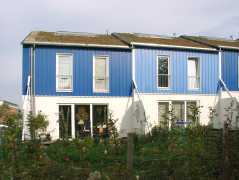Passive
House Standard – |
|
| American
visitors: Want to convert to US-units? Find a convinient tool here: The Passive House Sliding Converter! |
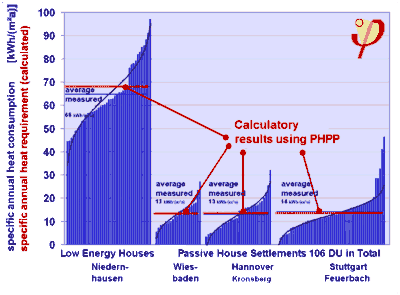
Fig. 1 Overview of consumption
measurements: This diagram shows measurements for the heating
energy consumption of four developments: One low-energy development (left)
and three passive house developments to the right.
See
an extended diagramm in higher resolution.
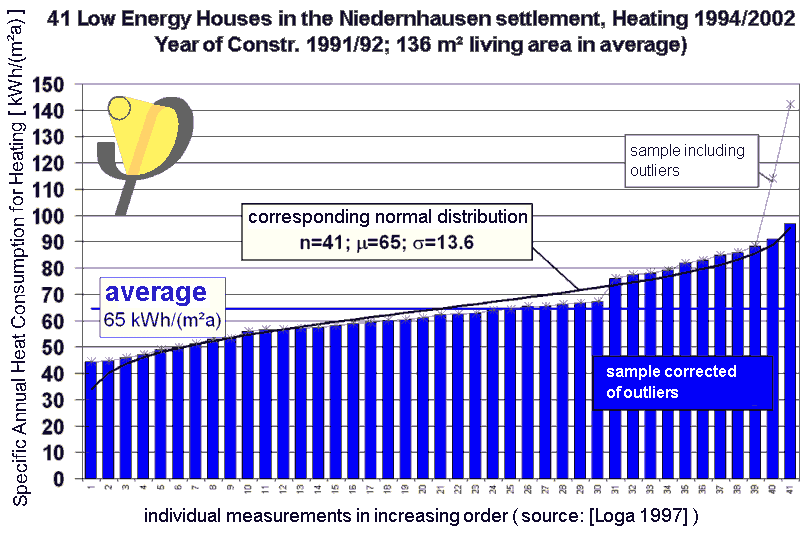
Fig.
2 Consumption statistics for a low-energy development: 41 low-energy
homes in Niedernhausen, completed and occupied in 1992. Consumption measurements
by T. Loga and M. Grossklos [Loga 1997]. The average consumption of 65
kWh/(m²a) reasonably verifies the accuracy of the calculated heat requirement
of 68 kWh/(m²a) [PHPP] (The inserted curve is
the associated Gaussian distribution - note for those
familiar with the mathematics 2).
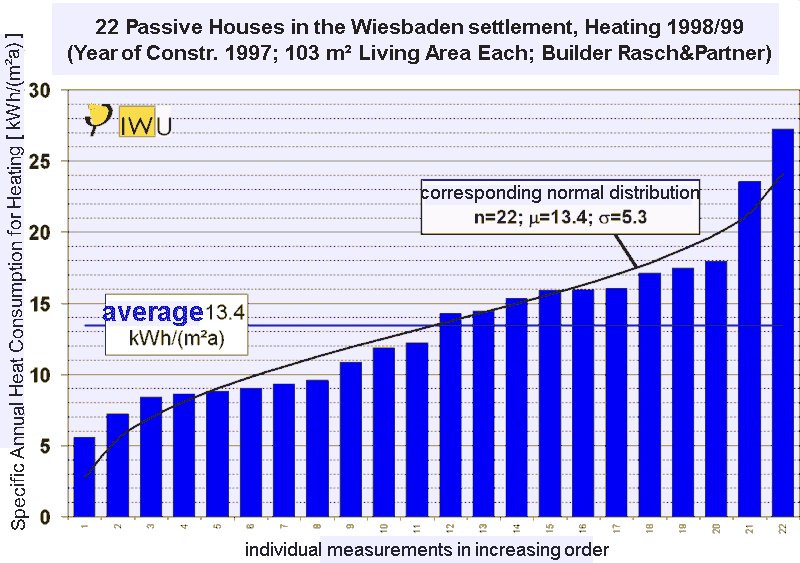
Fig. 3
Consumption statistics for the Passive House development in Wiesbaden:
The development of 22 Passive Houses was built in 1997. The average consumption
of 13.4 kWh/(m²a) matches very closely the calculated heat requirement
of 13 kWh/(m²a) [PHPP]. (Note for those familiar
with the mathematics 2)
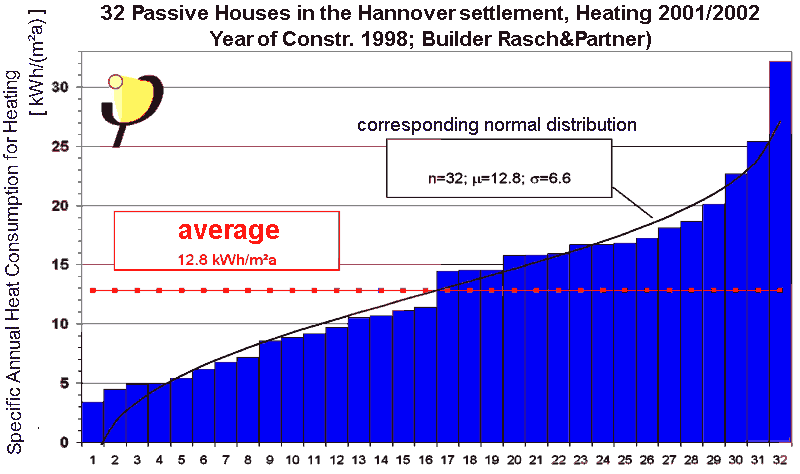
Fig. 4 Consumption
statistics for the Passive House development Hannover Kronsberg: The development
of 32 passive houses was occupied in 1999. Average consumption during
the third year of operation (2001/2002) was 12.8 kWh/(m²a). The heat
requirement according to the [PHPP] calculations
amounts to
13.5 kWh/(m²a). (Note for those familiar with the mathematics 2)

Fig. 5 Consumption statistics for the Passive House development Stuttgart/Feuerbach: The development of 52 passive houses was finished in the year 2000 (architect's office Rudolf). Average consumption was at 12.8 kWh/(m²a). The heat requirement calculations according to the [PHPP] amount to 13.5 kWh/(m²a) (note for those familiar with the mathematics 2).
1) Regarding the units: a kWh (kilowatt-hour) is an energy unit. A liter fuel oil (1 L) or 1 m³ natural gas has a heat energy value of 10 kWh. Here the annual heat requirement (qH) is used for the comparison:
qH = QH
/ ATFA.
QH the measured annual heating energy consumption. All measurements
were taken at the central location of heat distribution in each building
(usually with heat energy data loggers; the method is described in more
detail in the scientific reports quoted in each case).
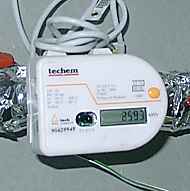 |
Example: Data loggers with m-bus outputs were used in all 32 town houses of the passive house development Hanover Kronsberg. The entire measuring technique is described in [ Peper/Feist 2001 ]. Additionally, there is an overall data logger on the central supply line for each row of town houses to double-check the results. |
This measurement includes distribution and heat delivery losses but not losses of the boiler.
ATFA is the energy reference area. For all results specified herein, this refers to the Treated Floor Area, that is a net-floor-area; selected as such in order to match the area that a standard heating bill and general heat consumption statistics are based on in Germany. It is important to note that the area AN, based on the calculations prescribed by the EnEV, is approximately 20 to 30% larger than the actual inhabitable floor space. Therefore, energy consumption determined using the EnEV method will appear to be much lower than it actually is. For this reason, we consistently use only the actual usable net floor area for our calculations.
2)
Inserted into the diagrams are the associated Gaussian or
normal distributions:
1/(σ√2√π)∫
e - ½ (x-μ)²/&sigma²,
to be precisely the inverse of those, thus the function, which is available
in spreadsheet programs with "Norminv".
μ describes the average
value and
σ the standard deviation
Additionally, n is the number
of buildings in a sample group. A closer look at the diagrams shows that
the heating consumption values of identically constructed objects are
approximated very well by a normal distribution. More details can be found
additionally in the CEPHEUS final report [ Schnieders/Feist 2001 ]
(Chi square test; Kolmogoroff -Smirnov-test). In this paper it is also
discussed, what the effect is of cutting the distribution off at zero.
Link to Basic informations about Passive Houses Passive House fundamentials.
Link to the Passive House Conference
Passive House Conference.
Link to the site of the Passive
House Institute: ![]()
This Internet information is based on published scientific reports. The sources are indicated and the reports are accessible to everybody. The associated field surveys were accomplished by three independent institutes: The Passivhaus Institut (PHI), Institut Wohnen und Umwelt (IWU) and the Fraunhofer Institut fuer Bauphysik (IBP). The results presented here are supported through further field surveys, which the Fraunhofer Institut fuer Solar Energy Systems (ISE) conducted.
Beyond those field tests, everyone has the opportunity to inform himselve about actual experiences with living in Passive Houses. Because every year at the beginning of Novembre the IG-Passivhaus organizes the "Day of the Passive House". During this day many Passive Houses open their doors for visitors. Interested individuals can then ask the inhabitants directly to share their experiences. The very remarkable energy savings of Passive Houses do not have any impact on the comfort in a home. To the contrary, the indoor air quality in a Passive House is excellent due to the constant supply of fresh air and there is a very steady indoor climate. To learn more about this please read the publication on Passive House comfort.
Is
the Passive House an Extreme version of energy efficient construction?
Many people think that a Passive House must be an expensive home because it achieves such high energy savings. However, that is not the case: the efficiency is improved in the areas of the building, where quality is already required if one wants to build a new home. Therefore it is possible, by designing a Passive House, to have lower lifecycle costs than with regular new construction. This is possible because the Passive House really achieves the promised energy savings - as we have shown for the developments documented here.
When calculating the heat requirement
of a building, the properties of materials and average climatic data are
taken into account – though in practice one will find that the actual
energy consumption of a building is also strongly influenced
by varying user behavior and changes in weather patterns. Many years of
monitoring the actual energy performance data of existing
Passive Houses have allowed for the statistical evaluation of these measurements.
The results confirm that energy performance predictions for passive houses
hold true in practice and that the Passive House concept is absolutely
reliable.
When monitoring the energy
performance of identically constructed homes one will find that the measured
results are often very different from house to house, because homeowner
usage varies from family to family. Therefore, the energy consumption
of a sufficient number of identically constructed homes must be evaluated,
so that the varying conditions of operation average out and a true comparison
of the overall building energy performance becomes possible. Fig.1 on
the left side shows a diagram of measured results for 41 low – energy
homes and for a total of 106 Passive Houses. These actual results allow
further conclusions.
Low-Energy Development in Niedernhausen
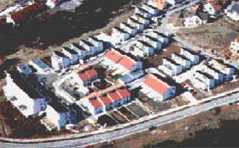
|
For comparison we will take a closer look at the low-energy development of 41 town homes in Niedernhausen. The individual heating energy consumption for each home measured in the year 1994 is shown in Fig. 2 (measurements by: [Loga 1997]). The average value of all homes measured is 65.56 kWh/(m²a). (For explanation regarding units see note 1) |
Passive
House Settlement Wiesbaden/Dotzheim
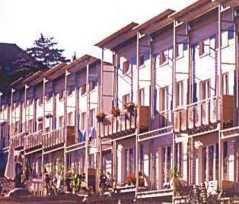
|
This project was the
first Passive House development in Germany (Built in 1997, by Rasch
& Partner) and consists of 22 homes. Fig. 3
documents the heat consumption of the winter season 1998/99. The average
value is determined to be 13.4 kWh/(m²a). This means that the average heat consumption of the Passive House development is 80% lower than that of the low-energy development in Niedernhausen. |
The standard deviation of the individual values is ±5.3 kWh/(m²a) and is also much lower than that of the low-energy development. However, the variation due to user behavior is more pronounced relative to the significantly smaller average consumption. The standard deviation of the average value is statistically determined to be ±1.1 kWh/(m²a). The energy conservation by the Passive House standard is statistically determined to be
80%
±5% in savings compared to the low energy standard,
and
92% ±1% in savings
compared to average heating consumption
in dwellings in Germany. (Measurements done by: [Ebel 2003]; [Feist/Loga/Grossklos
2000])
Passive
House Settlement Hannover/Kronsberg
|
The Passive House development Hannover Kronsberg consists of 32 essentially identical Passive town houses. The development was established in 1998/99; all home units were calculated individually. The Kronsberg homes are part of the CEPHEUS-project. Fig. 4 documents the energy consumption for the heating season of 2001/2002. The average value amounts to 12.8 kWh/(m²a). Thus, the overall consumption compared to the low-energy development Niedernhausen is 81% lower. [Peper/Feist 2002] |
2. Heating season 2000/2001: 13,3 kWh/(m²a)
3. Heating season 2001/2002: 12,8 kWh/(m²a).
Based on the measurement results, the extremely low heat consumption has also been statistically determined for the Passive House development in Hannover Kronsberg. The standard deviation of the individual values amounts to 6.6 kWh/(m²a), the average deviation is determined to be ±1.2 kWh/(m²a).
Passive
House Settlement Stuttgart/Feuerbach
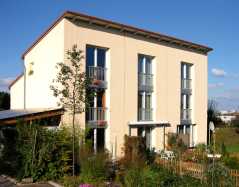
|
The Passive House development in Stuttgart Feuerbach with altogether 52 town houses and duplexes was finished in the year 2000 by the Rudolph architect's office. Fig. 5 documents the energy consumption of the heating season 2001/2002. The average consumption amounts to 12.8 kWh/(m²a) [Reiss/Erhorn 2003]. Obvious outliers in the consumption patterns can be observed in this development. |
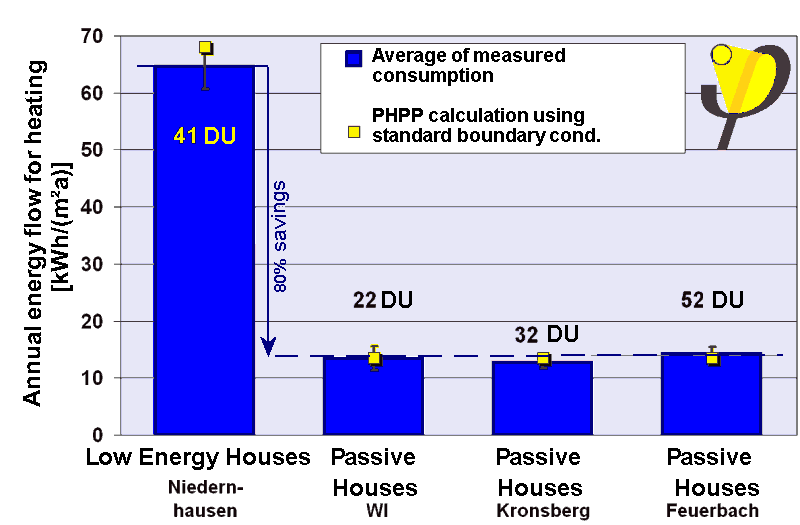
Fig. 6: This diagram summarizes the comparison of the energy consumption results of the low-energy development (left, 65 kWh/(m²a)) with the three Passive House developments (approximately 13 kWh/(m²a) in each case). The consumption in Passive House developments by measured results is about 80% less than in already very energy efficient low-energy homes. All field-measured and averaged results match closely the apriori ( in advance) calculated heat requirements using the Passive House Planning Package (PHPP).
Conclusions
The measurements in the realized passive house developments show:
- The individual measures taken, i.e. thermal insulation, triple-glazing and heat recovery are effective. Already deviations of more than 1 kWh/(m²a) would be recognizable in the average consumption values, but they do not arise.
- The calculation method and the used boundary conditions work satisfactorily in practice. The deviations between the calculated values and the measured values are very small.
- Additional heat
loss, as so called "heat delivery losses" or high
"window ventilation losses" cannot have a significant
influence considering the available consumption statistics;
they must lie within the limits determined with ±1 kWh/(m²a)
and are therefore negligible.
Summary
Different users have, even if they live in identically constructed houses, frequently very different consumption results: Deviations of ±50% from the average consumption value are not exceptional. This is not only the case in houses constructed following the Passive House principles, but holds true for other construction types as well. This deviation is caused mainly by different thermostat settings during the heating season.
Additionally, the maximum energy consumption in Passive Houses is still significantly lower than the lowest usage in average new buildings. As has been proven, the Passive House concept leads to very high energy savings, reproducibly, which amounts to more than 90% savings compared to existing buildings and to still on average 80% compared to the energy code requirements for new construction in Germany (which is quite good compared to other standards in the world).
Literature (small printed ones available only in German):
[Ebel 2003] Ebel, W.; Großklos, M.; Knissel, J.; Loga, T. und Müller, K.: Wohnen in Passiv- und Niedrigenergiehäusern – Eine vergleichende Analyse der Nutzungsfaktoren am Beispiel der „Gartenhofsiedlung Lummerlund“ in Wiesbaden-Dotzheim, Endbericht / Energie; Institut Wohnen und Umwelt; Darmstadt 2003.
[Feist/Loga/Großklos
2000] Feist, W.; Loga, T. und Großklos, M.:
Durch Messungen bestätigt – Jahresheizenergieverbrauch bei 22 Passivhäusern
in Wiesbaden unter 15 kWh/m² Wohnfläche, in BundesBauBlatt,
3/2000, S. 23-27.
[Loga 1997] Loga,
Tobias; Müller, Kornelia; Menje, Horst:
Die Niedrigenergiesiedlung Distelweg in Niedernhausen, Ergebnisse des
Messprogramms,
1. Auflage, Institut Wohnen und Umwelt, 1997.
[Peper/Feist 2001] Peper, Sören;
Feist, Wolfgang: Messtechnische Untersuchung und Auswertung -
Klimaneutrale Passivhaussiedlung Hannover-Kronsberg; 1. Auflage,
Proklima, Hannover 2001; this report can be orderes for free from proKlima.
You may downlod an English version from this link: Passive
Houses Kronsberg ( ![]() pdf,
english, 4.5 MB big file)
pdf,
english, 4.5 MB big file)
[Peper/Feist 2002] Peper, Sören;
Feist, Wolfgang: Klimaneutrale Passivhaussiedlung Hannover-Kronsberg
Analyse im dritten Betriebsjahr;
1. Auflage, Proklima, Hannover 2002; this report can be orderes for free
from proKlima.
You may downlod an English version from this link:
Passive
Houses Kronsberg ( ![]() pdf,
english, 4.5 MB big file)
pdf,
english, 4.5 MB big file)
[Reiß/Erhorn 2003] Reiß, Johann und Erhorn, Hans: Messtechnische Validierung des Energiekonzeptes einer großtechnisch umgesetzten Passivhausentwicklung in Stuttgart-Feuerbach, IBP-Bericht WB 117/2003, Fraunhofer-Institut für Bauphysik, Stuttgart 2003.
[Schnieders/Feist 2001] Schnieders,
Jürgen; Feist, Wolfgang; Pfluger, Rainer; Kah, Oliver: CEPHEUS
- Scientific Analysis, Final Report, Project Information Nr.
22, 1. edition, Passive House Institute, 2001
A short-version of the final CEPHEUS report this report can be ordered
in English language for free from proKlima.
(updated: 2007-05-10 author: Dr. Wolfgang Feist; thanks to Katrin Klingenberg for helping with we translation.
© Passive House Institute; unchanged copy is permitted, please give reference to this page)

